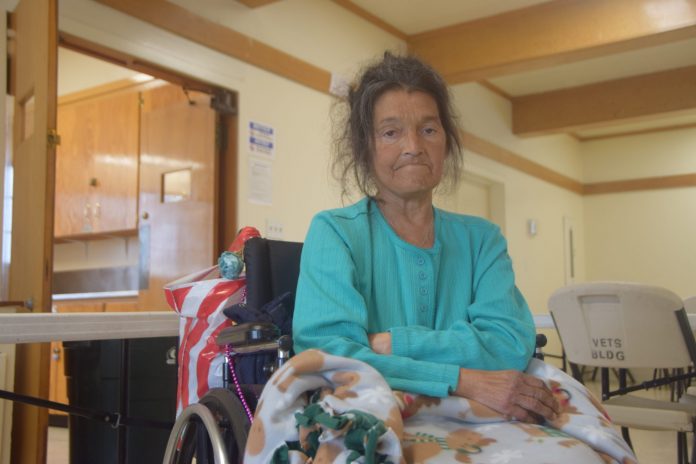Who are the Gilroyans some have labeled “the homeless?” They are young, and they are old. They are full of hope, and they are lost in despair. They have dignity and determination to battle for self-betterment and permanent housing for themselves and their families, and they have all but given up and struggle to only live day to day.
These are some of their stories.
Mary
On Monday morning, as the sky still hung heavy with rain clouds, Mary Gracia checked out of a hotel room paid for four nights by the Compassion Center. Gracia sat in her wheelchair, picking at the meal provided. She is thin and frail, resembling a woman thirty years older than her 52 hard-loved years on earth.
“I don’t know what I’m going to do,” Gracia said between sobs. “I don’t know where I’ll be tonight. Probably by Stubby’s or the 7-11. I just want a place so bad. A shack, a shed. Anything.”
Life has been hard for Gracia. She has been homeless since 1999, after suffering from years of abuse, drug addiction and a series of worsening tragedies. Her health has steadily and severely declined during her years of homelessness. A bone infection and the ensuing surgical complications have left Gracia mostly dependent upon her wheelchair.
“I’ve had a very hard life; I was abused, then my son died a couple years ago after he was hit by two cars,” Gracia said. “A couple of years ago something broke loose from above my tent and fell on me. I couldn’t move and it took days for someone to find me. Everybody always steals from me too. Especially the young kids and people from the gangs.”
Gracia has indeed been taken advantage of according to Dee Pearse of the Compassion Center.
“A lot of older homeless people are very often taken advantage of,” Pearse said. “They get Social Security and a lot of times they have the older people buy them stuff. That happens to Mary. They act like they are Mary’s friends, then they make her buy things for them, then they just dump her off again.”
On Tuesday, Jan. 22, Santa Clara County issued a warning for the area’s homeless, warning them of incoming severe weather. For Gracia, as the storm clouds gathered once more, it’s unknown where she will be, when storms clouds break loose again.
Odman
Another, a man who calls himself Odman, among other pseudonyms, is short and skinny. He has thick, wavy jet black hair and he’s heavily tattooed, defiant and street-tough. He’s also a longtime Gilroyan who describes himself as a heavy drinker who has been on the streets for almost 20 years.
“Hell yes I’m a drinker, I was drinking today,” said Odman, 40, with breath pungent with what smelled like liquor. “I only have half a foot, want to see? I got hit by a car but I was so drunk that I didn’t get it looked at until 15 hours later. I didn’t even feel it. I just went and got more drunk. For months I used a skateboard to get around. My brother was like, ‘Well you were a skateboarder anyway.’ So I would just sit on it and roll around.”
A graduate of Gilroy High School who has an 18-year-old daughter he rarely sees, Odman doesn’t hide who he is or why he’s on the streets.
“I did them myself,” Odman said of his tattoos. “This one here (pointing to a tattoo on his wrist which reads, 5150), ‘criminally insane.’” This one and this one, (pointing to his left inner bicep, then his right inner bicep), ‘self,’ ‘inflicted,’ it says.”
Debbie and Richard
Debbie and Richard, native Gilroyans with two kids, a son aged 18 and a daughter, 16, lost their home in July when the owner of the home they rented sold the house and the new landlord raised the rent from $1,800 to $2,400. For now, they’re staying at the Ochoa Migrant Camp, which is open to homeless families from Late November until the end of March while the migrant families are away.
“I used to work driving a truck for a porta-potty business but I lost that job in 2011,” Richard, 47 said. “I’ve had three heart attacks, four stents, type-2 diabetes, an arthritic neck and two degenerative knees. It’s a struggle, but I pray every day and every week I go to mass at St. Mary’s.”
For now, they are comfortable at Ochoa Camp. They have food provided and the living conditions are comfortable at the moment. On March 31, when Ochoa Camp is again open for migrant worker families, it will be closed to the homeless. Even though Debbie works at a Taco Bell, the income is far shy of what they would need to move into a new apartment.
Rene and Jacqueline
Rene Martinez was born in Brownfield Texas but moved to Gilroy with his parents when he was one year old 55 years ago. A little more than a month ago, while he was crossing the street on Leavesley Road and Forrest Street he was hit by a car.
“I had the right away and everything,” Martinez, who gets around on crutches, claimed. “Next thing I know, pow. My face hit the windshield and I went flying. I broke my pelvis and everything here on my right side is all busted up. If I get hurt again like if I fall, they tell me I’ll be in a wheelchair the rest of my life.”
Martinez is now completely dependent on his girlfriend, Jacqueline Robbles, for nearly everything now. Robbles, who has been homeless for eight years, was joined on the streets by Martinez for protection, according to him. Now, a life that was already difficult has become far more perilous.
“I yell at her a lot to hurry up,” Martinez said as Robbles cried softly nearby. “I regret it later. But I’m frustrated now and I can’t do anything for myself. I’m out here to protect her though. Whenever people come by the tent at night and bother us, I get out of the tent with a flashlight and scare them off. I may be hurt right now, but I’ll still fight them.”
Donations to the Compassion Center can be made online at gilroycompassioncenter.blogspot.com or on their Facebook page. Donations can also be dropped off directly at the Compassion Center.















There are vacant lots along the bus route that the City of Gilroy, and Morgan Hill, if they own the land, or it is County land, that they could make a tent city for the homeless of that city. They did this during the depression, and had wood platforms and then the army had extra tents that they used. It was a community, except then people were just homeless, not drug addicts, and they kept the area clean and had a P.O pickup for mail. We have lots of stored old tents that the Army has stored somewhere and does not use, why don’t the cities try to help with a TENT CITY???